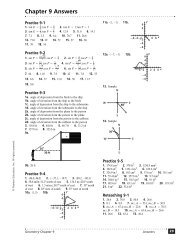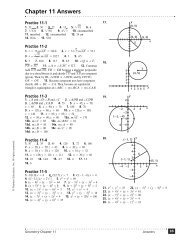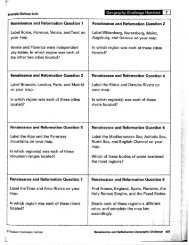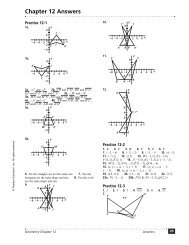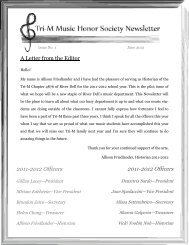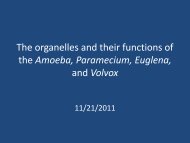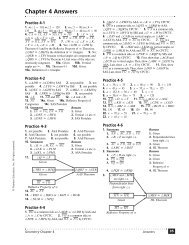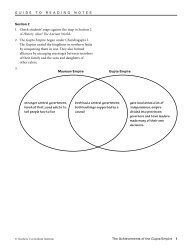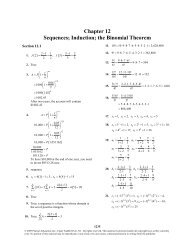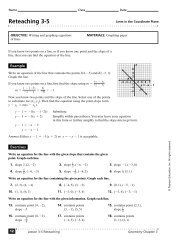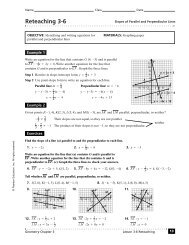Unit 2 Lesson 2 Protists and Fungi
Unit 2 Lesson 2 Protists and Fungi
Unit 2 Lesson 2 Protists and Fungi
Create successful ePaper yourself
Turn your PDF publications into a flip-book with our unique Google optimized e-Paper software.
<strong>Unit</strong> 2 <strong>Lesson</strong> 2 <strong>Protists</strong> <strong>and</strong> <strong>Fungi</strong><br />
Copyright © Houghton Mifflin Harcourt Publishing Company
<strong>Unit</strong> 2 <strong>Lesson</strong> 2 <strong>Protists</strong> <strong>and</strong> <strong>Fungi</strong><br />
On the Move!<br />
What are some characteristics of<br />
protists?<br />
• The kingdom Protista is a group of eukaryotic<br />
organisms that cannot be classified as fungi,<br />
plants, or animals.<br />
• Members of the kingdom Protista are called<br />
protists, which are a very diverse group of<br />
organisms.<br />
• Many members are not closely related or are more<br />
closely related to members of other kingdoms, so<br />
classification of protists is likely to change.<br />
Copyright © Houghton Mifflin Harcourt Publishing Company
<strong>Unit</strong> 2 <strong>Lesson</strong> 2 <strong>Protists</strong> <strong>and</strong> <strong>Fungi</strong><br />
What are some characteristics of<br />
protists?<br />
• Most protists are single-celled organisms that<br />
cannot be seen without a microscope.<br />
• Diatoms are single-celled protists that have cell<br />
walls with unusual shapes.<br />
• Some have many cells, <strong>and</strong> some live in colonies.<br />
Volvox, a kind of green algae, has cells that form<br />
spherical colonies.<br />
Copyright © Houghton Mifflin Harcourt Publishing Company
<strong>Unit</strong> 2 <strong>Lesson</strong> 2 <strong>Protists</strong> <strong>and</strong> <strong>Fungi</strong><br />
What are some characteristics of<br />
protists?<br />
• <strong>Protists</strong> have membrane-bound organelles, which<br />
are structures that carry out jobs inside a cell.<br />
• Many protists have contractile vacuoles that<br />
remove excess water from the cell.<br />
• Some protists have structures for movement.<br />
Most protists that move do so in order to find<br />
food.<br />
Copyright © Houghton Mifflin Harcourt Publishing Company
<strong>Unit</strong> 2 <strong>Lesson</strong> 2 <strong>Protists</strong> <strong>and</strong> <strong>Fungi</strong><br />
What are some characteristics of<br />
protists?<br />
• Some protists move by using cilia or hairlike<br />
structures that beat rapidly back <strong>and</strong> forth.<br />
Copyright © Houghton Mifflin Harcourt Publishing Company
<strong>Unit</strong> 2 <strong>Lesson</strong> 2 <strong>Protists</strong> <strong>and</strong> <strong>Fungi</strong><br />
What are some characteristics of<br />
protists?<br />
• Other protists use a flagellum, a whiplike structure<br />
that propels the cell forward, to move.<br />
• Amoebas move by stretching their bodies, forming<br />
a pseudopod or “false foot.” When cytoplasm flows<br />
into the pseudopod, the rest of the cell follows.<br />
Copyright © Houghton Mifflin Harcourt Publishing Company
<strong>Unit</strong> 2 <strong>Lesson</strong> 2 <strong>Protists</strong> <strong>and</strong> <strong>Fungi</strong><br />
Protist Production<br />
How can protists reproduce?<br />
• Most protists can reproduce asexually, when the<br />
offspring come from just one parent.<br />
• Every organism can produce offspring that are<br />
genetically identical to the parent.<br />
Copyright © Houghton Mifflin Harcourt Publishing Company
<strong>Unit</strong> 2 <strong>Lesson</strong> 2 <strong>Protists</strong> <strong>and</strong> <strong>Fungi</strong><br />
How can protists reproduce?<br />
• <strong>Protists</strong> can reproduce asexually by binary fission<br />
<strong>and</strong> fragmentation.<br />
• During binary fission, a single-celled protist copies<br />
its DNA. The protist then divides into two cells,<br />
each of which has a copy of the DNA.<br />
• In fragmentation, a piece breaks off an organism<br />
<strong>and</strong> develops into a new individual. Many<br />
multicellular protists reproduce this way.<br />
Copyright © Houghton Mifflin Harcourt Publishing Company
<strong>Unit</strong> 2 <strong>Lesson</strong> 2 <strong>Protists</strong> <strong>and</strong> <strong>Fungi</strong><br />
How can protists reproduce?<br />
• Some protists reproduce sexually, when two cells,<br />
called gametes, join together.<br />
• Each gamete contains a single copy of the genes<br />
for the organism. A cell with one copy of genetic<br />
material is haploid; a cell with two copies is<br />
diploid.<br />
• Each gamete comes from a different parent. When<br />
the haploid gametes join, the diploid offspring has<br />
a unique combination of genetic material.<br />
Copyright © Houghton Mifflin Harcourt Publishing Company
<strong>Unit</strong> 2 <strong>Lesson</strong> 2 <strong>Protists</strong> <strong>and</strong> <strong>Fungi</strong><br />
How can protists reproduce?<br />
• In some protists, generations alternate between<br />
using sexual <strong>and</strong> asexual reproduction.<br />
• Haploid generation adults are called<br />
gametophytes. Diploid generation adults are<br />
called sporophytes.<br />
• Dipolid adults undergo meiosis to make haploid<br />
spores. Spores are reproductive cells that are<br />
resistant to stressful environmental conditions.<br />
Copyright © Houghton Mifflin Harcourt Publishing Company
<strong>Unit</strong> 2 <strong>Lesson</strong> 2 <strong>Protists</strong> <strong>and</strong> <strong>Fungi</strong><br />
How can protists reproduce?<br />
• These spores develop into haploid adults, which<br />
undergo mitosis to form haploid gametes.<br />
• Two gametes join to form a diploid zygote, which<br />
grows into a diploid adult.<br />
• This continuing cycle is called alternation of<br />
generations.<br />
Copyright © Houghton Mifflin Harcourt Publishing Company
<strong>Unit</strong> 2 <strong>Lesson</strong> 2 <strong>Protists</strong> <strong>and</strong> <strong>Fungi</strong><br />
How can protists reproduce?<br />
• Use the terms diploid, haploid, <strong>and</strong> adult to<br />
describe how organisms reproduce with<br />
alternating generations of diploid <strong>and</strong> haploid cells.<br />
Copyright © Houghton Mifflin Harcourt Publishing Company
<strong>Unit</strong> 2 <strong>Lesson</strong> 2 <strong>Protists</strong> <strong>and</strong> <strong>Fungi</strong><br />
A Diverse Group<br />
What are different kinds of protists?<br />
• Animal-like protists cannot make their own food.<br />
• They get nutrients by ingesting other organisms.<br />
Many eat small organisms such as bacteria, yeast,<br />
or other protists.<br />
• Most animal-like protists can move, allowing them<br />
to search for food.<br />
Copyright © Houghton Mifflin Harcourt Publishing Company
<strong>Unit</strong> 2 <strong>Lesson</strong> 2 <strong>Protists</strong> <strong>and</strong> <strong>Fungi</strong><br />
What are different kinds of protists?<br />
• Fungus-like protists absorb nutrients from the<br />
environment. Many absorb nutrients from living or<br />
dead organisms.<br />
• Fungus-like protists produce spores that are used<br />
in reproduction.<br />
• <strong>Protists</strong> release spores into the environment. The<br />
spores can survive through periods of harsh<br />
conditions.<br />
Copyright © Houghton Mifflin Harcourt Publishing Company
<strong>Unit</strong> 2 <strong>Lesson</strong> 2 <strong>Protists</strong> <strong>and</strong> <strong>Fungi</strong><br />
What are different kinds of protists?<br />
• Plant-like protists are producers, which means they<br />
use the sun’s energy to make food through<br />
photosynthesis.<br />
• Single-celled, free-floating, plant-like protists are a<br />
main part of the ocean’s phytoplankton.<br />
• Phytoplankton—tiny, floating organisms—provide<br />
food for larger organisms. They also produce much<br />
of the world’s oxygen.<br />
Copyright © Houghton Mifflin Harcourt Publishing Company
<strong>Unit</strong> 2 <strong>Lesson</strong> 2 <strong>Protists</strong> <strong>and</strong> <strong>Fungi</strong><br />
What are different kinds of protists?<br />
• Multicellular plant-like protists are called algae.<br />
• All algae have the green pigment chlorophyll in their<br />
cells. Many also have other pigments.<br />
• Algae are grouped by color, which determines what<br />
wavelengths of light the algae can absorb. The three<br />
main groups are brown algae, red algae, <strong>and</strong> green<br />
algae.<br />
Copyright © Houghton Mifflin Harcourt Publishing Company
<strong>Unit</strong> 2 <strong>Lesson</strong> 2 <strong>Protists</strong> <strong>and</strong> <strong>Fungi</strong><br />
Lots of Fun(gi)!<br />
What are some characteristics of fungi?<br />
• <strong>Fungi</strong> are spore-producing organisms that absorb<br />
nutrients from the environment. Because they are<br />
so different from other organisms, fungi are<br />
placed in their own kingdom.<br />
• <strong>Fungi</strong> are consumers, which means they cannot<br />
make their own food. They cannot move to catch<br />
organisms to eat.<br />
• <strong>Fungi</strong> get nutrients by secreting digestive juices<br />
onto a food source <strong>and</strong> then absorbing nutrients<br />
from the dissolved food.<br />
Copyright © Houghton Mifflin Harcourt Publishing Company
<strong>Unit</strong> 2 <strong>Lesson</strong> 2 <strong>Protists</strong> <strong>and</strong> <strong>Fungi</strong><br />
What are some characteristics of fungi?<br />
• Many fungi are decomposers, which get nutrients<br />
from dead matter.<br />
• All fungi are made of eukaryotic cells that have<br />
nuclei.<br />
• <strong>Fungi</strong> are unique because their cell walls contain<br />
chitin, a hard substance that strengthens the cell<br />
walls.<br />
Copyright © Houghton Mifflin Harcourt Publishing Company
<strong>Unit</strong> 2 <strong>Lesson</strong> 2 <strong>Protists</strong> <strong>and</strong> <strong>Fungi</strong><br />
What are some characteristics of fungi?<br />
• Some fungi are single-celled. Most are made up of<br />
many cells that form chains, or threadlike fungal<br />
filaments called hyphae.<br />
• Most hyphae in a fungus form a twisted mass<br />
called a mycelium, which makes up the major part<br />
of the body of a fungus.<br />
Copyright © Houghton Mifflin Harcourt Publishing Company
<strong>Unit</strong> 2 <strong>Lesson</strong> 2 <strong>Protists</strong> <strong>and</strong> <strong>Fungi</strong><br />
What are some characteristics of fungi?<br />
• Thread-like hyphae make up the body of this<br />
mushroom. Most of the hyphae are underground.<br />
Copyright © Houghton Mifflin Harcourt Publishing Company
<strong>Unit</strong> 2 <strong>Lesson</strong> 2 <strong>Protists</strong> <strong>and</strong> <strong>Fungi</strong><br />
How can fungi reproduce?<br />
• Asexual reproduction in fungi occurs in three ways.<br />
In fragmentation, hyphae break apart, <strong>and</strong> each<br />
piece becomes a new fungus.<br />
• In budding, a small portion of a parent cell pinches<br />
off to become a new individual.<br />
• In asexual reproduction by spores, hyphae produce<br />
a long stalk called a sporangium, in which spores<br />
develop through mitosis <strong>and</strong> spread by wind.<br />
Copyright © Houghton Mifflin Harcourt Publishing Company
<strong>Unit</strong> 2 <strong>Lesson</strong> 2 <strong>Protists</strong> <strong>and</strong> <strong>Fungi</strong><br />
How can fungi reproduce?<br />
• In most fungi, sexual reproduction occurs when<br />
hyphae from two individuals join together,<br />
producing a special reproductive structure.<br />
• Genetic material from both individuals fuse to form<br />
diploid cells. The cells undergo meiosis to become<br />
haploid again. The spores are then released.<br />
• Like asexual spores, these spores also spread<br />
easily through the environment.<br />
Copyright © Houghton Mifflin Harcourt Publishing Company
<strong>Unit</strong> 2 <strong>Lesson</strong> 2 <strong>Protists</strong> <strong>and</strong> <strong>Fungi</strong><br />
What are some kinds of fungi?<br />
• Zygote fungi are named for sexual reproductive<br />
structures that produce zygotes inside a tough<br />
capsule.<br />
• Most of the fungi in this group live in the soil <strong>and</strong><br />
are decomposers.<br />
• A mold is a fast-growing fungus that reproduces<br />
asexually. Bread molds <strong>and</strong> molds that rot fruit are<br />
examples of this asexual stage of a zygote fungus<br />
life cycle.<br />
Copyright © Houghton Mifflin Harcourt Publishing Company
<strong>Unit</strong> 2 <strong>Lesson</strong> 2 <strong>Protists</strong> <strong>and</strong> <strong>Fungi</strong><br />
What are some kinds of fungi?<br />
• Sac fungi, the largest group of fungi, include yeasts,<br />
powdery mildews, morels, <strong>and</strong> bird’s-nest fungi.<br />
• Sac fungi reproduce asexually <strong>and</strong> sexually.<br />
Sexually produced spores develop within a<br />
microscopic sac that then opens to release the<br />
spores.<br />
• Most sac fungi are multicellular. Some single-celled<br />
sac fungi reproduce asexually by budding, which<br />
occurs when a new cell pinches off from an existing<br />
one.<br />
Copyright © Houghton Mifflin Harcourt Publishing Company
<strong>Unit</strong> 2 <strong>Lesson</strong> 2 <strong>Protists</strong> <strong>and</strong> <strong>Fungi</strong><br />
What are some kinds of fungi?<br />
• Club fungi are named for the microscopic structures<br />
in which the spores develop.<br />
• Club fungi are important decomposers of wood.<br />
Without fungi, the nutrients in wood could not be<br />
recycled.<br />
Copyright © Houghton Mifflin Harcourt Publishing Company
<strong>Unit</strong> 2 <strong>Lesson</strong> 2 <strong>Protists</strong> <strong>and</strong> <strong>Fungi</strong><br />
How do fungi form partnerships?<br />
• Some fungi grow on or in the roots of plants,<br />
providing nutrients to the fungus, which helps the<br />
roots absorb minerals. This is called a mycorrhiza.<br />
• A lichen is a partnership between a fungus <strong>and</strong> a<br />
green alga or cyanobacterium, which uses<br />
photosynthesis to make food.<br />
• The fungus gives protection, water, <strong>and</strong> minerals.<br />
For example, lichens provide food for animals in<br />
polar climates.<br />
Copyright © Houghton Mifflin Harcourt Publishing Company




